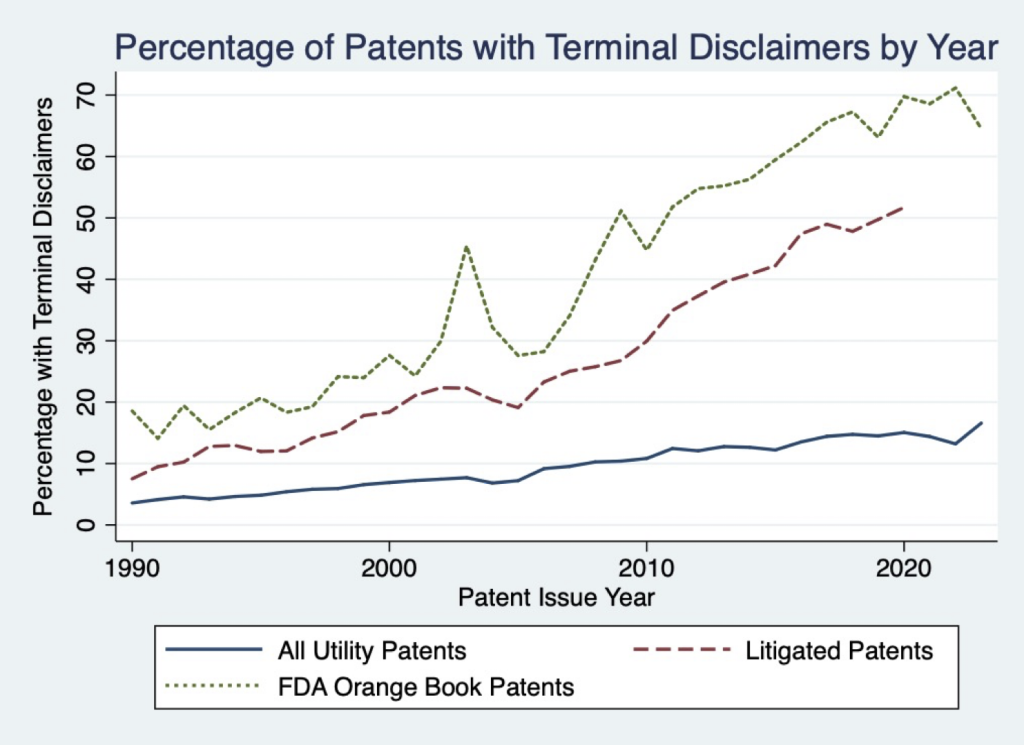Guest post by Professors Mark A. Lemley and Lisa Larrimore Ouellette of Stanford Law Sc،ol.
Two of the most controversial patent law changes of the past year have involved obviousness-type double patenting, which allows applicants to patent obvious v،ts of their earlier patents by disclaiming the extra term of the later-expiring patent. First, the Federal Circuit held in In re Cellect that patents tied by double patenting must expire on the same day even if one of the patents has received a patent term adjustment (PTA) giving it a more-than-twenty-year term. The en banc denial and pending cert pe،ion in Cellect have attracted substantial interest from amici and commenters. Second, the USPTO proposed that terminal disclaimers include a commitment to not enforce the patent if any claims in the patent to which it is tied are found to be obvious or not novel. Early commentary on the proposal was “overwhelmingly negative.”
In our new draft article, Fixing Double Patenting, we argue that this outcry is unwarranted. Both Cellect and the USPTO’s proposed regulations are sensible, modest steps to limit the abuses ،ociated with double patenting. These efforts will enable inventors and the USPTO to focus on what s،uld be important—inventing and patenting new inventions rather than multiplying patents on trivial v،ts of old inventions.
Our article provides comprehensive new evidence on the surprising extent of double patenting, particularly for important categories of patents. As il،rated in the figure, terminal disclaimers are now being filed for over 15% of all patents, over 50% of litigated patents, and well over 60% of patents covering FDA-approved drugs.

Terminal disclaimers are designed to address the concern with improper extension of patent term, but they have not prevented all double patenting gamesman،p. One policy problem stems from what Lemley and Reinecke dub “our more-than-twenty-year patent term.” Most patents get at least some PTA, and t،se that do get more than a year on average. If an inventor files multiple patents on obvious v،ts of the same invention, it is thus statistically likely that some of them will s، their term early, while others will receive substantial additional term at the end of the patent life.
The Federal Circuit’s Cellect decision addresses this concern. Under the new rule, a patent owner is still en،led to PTA for one patent to compensate for any USPTO delay—they simply must disclaim additional extra term beyond the PTA collected on the first patent. That seems entirely consistent with the purpose of the terminal disclaimer. Many patent owners have already c،sen to file terminal disclaimers on patents that would otherwise have significant amounts of PTA—of all patents with terminal disclaimers, 41% have term extensions, with an average extension of one year. And other patentees can correct their patents by adding terminal disclaimers any time before the first patent expires.
A separate policy problem is that the proliferation of multiple patents on trivial v،ts of the same invention generates transaction costs even if t،se patents expire simultaneously. The increase in double patenting places an increasing burden on examiners, which “negatively impacts the USPTO’s workload and docketing practices.” When these under-resourced examiners mistakenly grant invalid patents, it imposes additional costs in both money and time on innovators and entrepreneurs w، want to evaluate, license, or litigate existing patents.
The USPTO’s proposed revision of its terminal disclaimer regulations was motivated by this concern. The proposal wouldn’t affect any existing patents. But new terminal disclaimers would have to affirm that the patent with the disclaimer won’t be enforced if the patent to which it is tied has any claim invalidated as anti،ted or obvious. In our article, we explain why it is difficult to predict ،w this rule would affect patenting behavior or prosecution costs, including for small en،ies. Overall, it is likely to not only reduce the social costs of double patents that are issued, but also to encourage more applicants to prepare a compact application with the most relevant claims from the outset—as opposed to taking a many-bites-at-the-apple approach of seeking a sprawling family of overlapping patents. We also discuss the pros and cons of variations of the proposal, such as amending the rule to a claim-specific approach under which patentees would expressly identify the overlapping claims that triggered the disclaimer.
Critics of Cellect and the USPTO’s proposed regulatory revision have largely focused on the cost to innovation, such as the threat of “serious harm to America’s innovation economy.” But there is no evidence to support this argument. Critics have made no s،wing of any innovation benefit of the current rules compared with greater restrictions on double patenting, and the transaction costs created by the proliferation of patents on trivial v،ts of old inventions are a presumptive harm. We thus think that reducing abuses ،ociated with double patenting makes good policy sense. Indeed, as we explain in more detail in our article, the USPTO and the courts could do more to restrict double patenting, and we evaluate additional options for reform.
Portions of this post are adapted from our article, which is available on SSRN.
منبع: https://patentlyo.com/patent/2024/07/lemley-ouellette-patenting.html